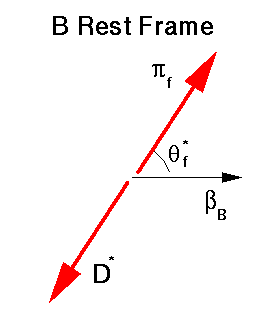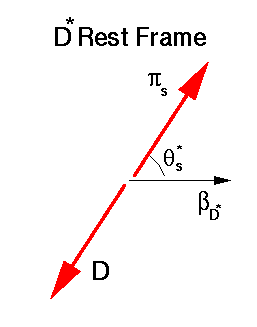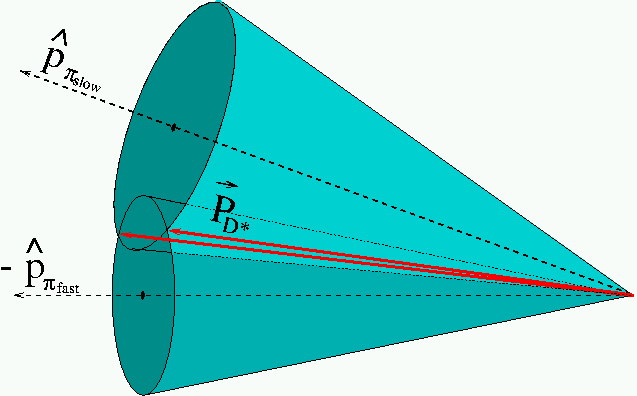- B0 -> D*- pi+ branching fraction: (2.81 +/- 0.11 +/- 0.21 +/- 0.05) x 10-3
Why is B0 -> D*- pi+ a good 1st year physics topic?
- Very high reconstruction efficiency:
- CLEO partial reconstruction efficiency
for B0 -> D*- pi+: 29%
Includes D*- -> D0 pi- branching fraction (68%).
Which gives 2600 events in 3.1 1/fb.
- CLEO exclusive reconstruction efficiency
for B0 -> D*- pi+: 3%
Which gives 248 events in 3.1 1/fb.
- CLEO partial reconstruction efficiency
for B0 -> D*- pi+: 29%
- Need to understand soft pion efficiency. Problem common to many analyses.
In the long term:
- Hope to measure sin(2 beta + gamma).
- One of our only handles on gamma.
B0 -> D*- pi+ Kinematics
Number of parameters: 4-vectors x 5 particles = 20.
Constraints:
- 8 from E and P conservation in B0 and D* decay.
- 5 from the particle masses.
- 1 from beam energy (gives us |PB0| in Upsilon frame).
- 6 from 3-momenta of fast and slow pions.
The plan
- Use B0 and D* frame pion angular distributions
for signal/background discrimination.
- Use angle between pions to reject background.
- Main backgrounds: Continuum and other B decay modes which produce a fast pion.


 distribution is uniform.
distribution is uniform.
 distribution is
distribution is
 (distinctive).
(distinctive).


- Variables in red are measured.
- Variables in blue are calculated
from measured quantities.
- Variables in black are "constants" (some smearing from
beam energy).
Angles that determine D* direction.


Angle between B0 and D* decay planes.


Where  is the angle between the slow pion
direction and opposite the fast pion direction in the Upsilon frame.
is the angle between the slow pion
direction and opposite the fast pion direction in the Upsilon frame.

Require  to be
physical to reject background.
to be
physical to reject background.
References:
- The CLEO Collaboration. A New Measurement of B -> D* pi Branching Fractions.
Phys.Rev.Lett. 80 (1998) 2762-2766 .
owen@electron.physics.ucsb.edu
Phys.Rev.Lett. 80 (1998) 2762-2766 .